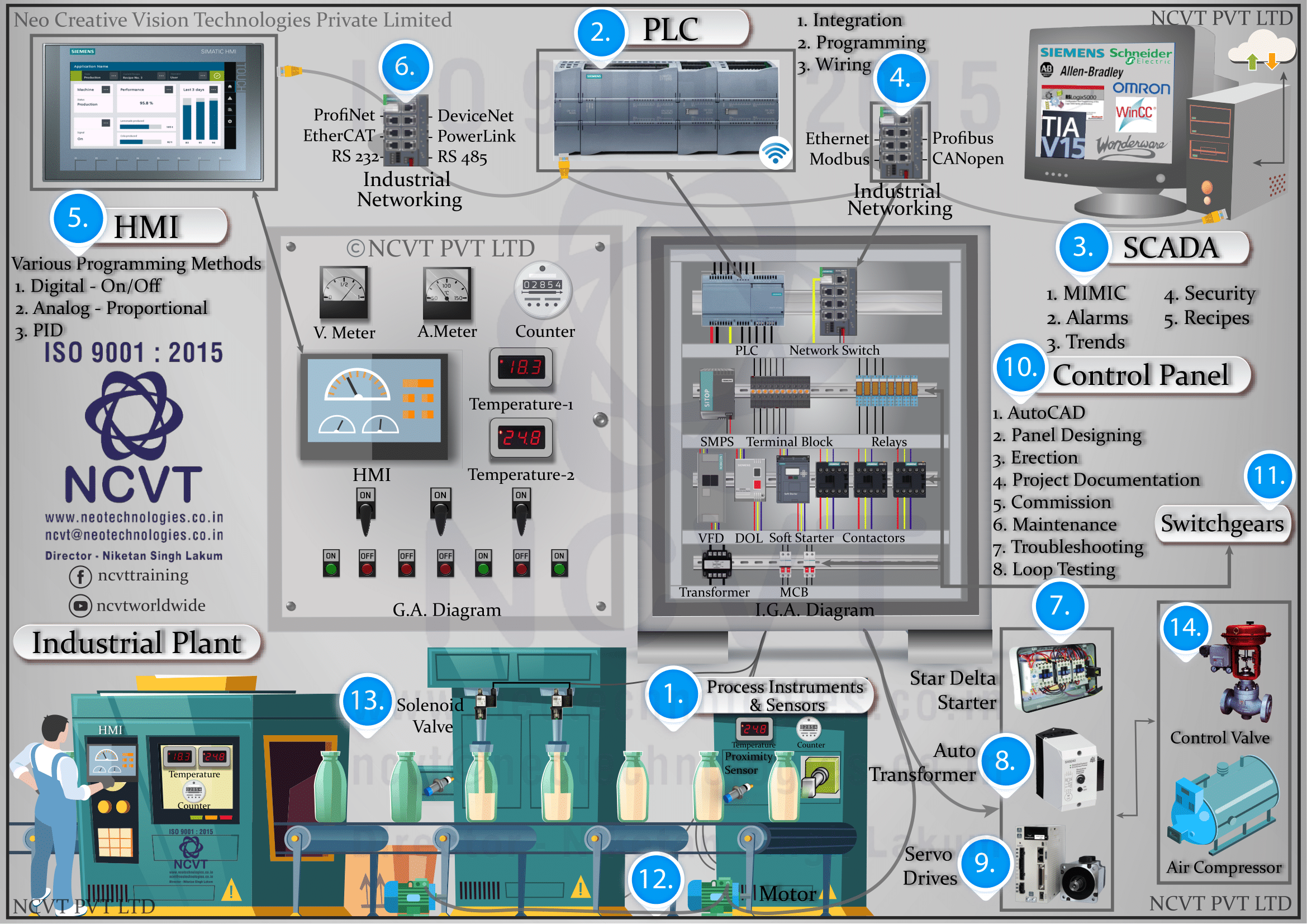
Industrial automation encompasses a wide range of technologies and systems designed to automate and optimize manufacturing and production processes. It involves the integration of various components and levels of automation to control machinery, equipment, and processes efficiently. Here’s an overview of how industrial automation works, along with the components and levels involved:
### 1. Components of Industrial Automation:
1. **Sensors:**
– Sensors detect physical variables such as temperature, pressure, flow, position, and level.
– They convert these physical variables into electrical signals for monitoring and control.
2. **Actuators:**
– Actuators are devices that convert electrical signals into mechanical motion or physical action.
– They control valves, motors, pumps, and other mechanical devices in response to control signals.
3. **Controllers:**
– Controllers receive input signals from sensors, process the data, and generate output signals to actuators.
– They include programmable logic controllers (PLCs), distributed control systems (DCS), and industrial PCs.
4. **Human-Machine Interfaces (HMIs):**
– HMIs provide a graphical interface for operators to monitor and interact with industrial processes.
– They display real-time data, alarms, trends, and control options for the operator’s convenience.
5. **Networking Infrastructure:**
– Networking infrastructure connects devices, controllers, and HMIs to facilitate data exchange and communication.
– It includes wired (e.g., Ethernet, Profibus) and wireless (e.g., Wi-Fi, Bluetooth) communication protocols.
6. **Software and Algorithms:**
– Software programs and algorithms control and optimize industrial processes based on input from sensors and feedback loops.
– They include control algorithms, PID controllers, machine learning models, and optimization algorithms.
### 2. Levels of Industrial Automation:
1. **Field Level:**
– The field level includes sensors, actuators, and other devices directly involved in monitoring and controlling physical variables.
– Sensors measure process variables, while actuators adjust process parameters based on control signals.
2. **Control Level:**
– The control level consists of controllers and programmable logic controllers (PLCs) responsible for processing sensor data and generating control signals for actuators.
– PLCs execute control algorithms, handle logic functions, and coordinate device communication.
3. **Supervisory Level:**
– The supervisory level involves human-machine interfaces (HMIs) and supervisory control and data acquisition (SCADA) systems.
– HMIs provide operators with a graphical interface to monitor and control industrial processes in real-time.
– SCADA systems collect, store, and analyze data from multiple sources for supervisory control and decision-making.
4. **Enterprise Level:**
– The enterprise level encompasses higher-level functions such as production planning, scheduling, and inventory management.
– It integrates with enterprise resource planning (ERP) systems for seamless coordination of production activities with business operations.
### 3. Working Principle of Industrial Automation:
1. **Data Acquisition:**
– Sensors collect data on process variables such as temperature, pressure, flow, and position.
– Analog signals from sensors are converted to digital signals for processing and analysis.
2. **Data Processing and Control:**
– Controllers receive input data from sensors and execute control algorithms to generate output signals.
– Control algorithms adjust process parameters to maintain desired setpoints and optimize performance.
3. **Communication and Networking:**
– Data is transmitted between sensors, controllers, HMIs, and other devices via wired or wireless communication networks.
– Industrial protocols such as Modbus, Profibus, and OPC facilitate data exchange and device interoperability.
4. **Human-Machine Interaction:**
– Operators interact with industrial processes through HMIs, where they monitor real-time data, view alarms, and issue control commands.
– HMIs provide visual feedback and facilitate decision-making for operators and supervisors.
5. **Data Analysis and Optimization:**
– SCADA systems and advanced software applications analyze data collected from sensors and control systems.
– Machine learning algorithms and optimization techniques identify patterns, trends, and anomalies to improve process efficiency and performance.
### Conclusion:
Industrial automation involves the integration of sensors, actuators, controllers, networking infrastructure, and software applications to monitor, control, and optimize manufacturing and production processes. Different levels of automation, from the field level to the enterprise level, coordinate functions and activities across the organization. By leveraging advanced technologies and intelligent algorithms, industrial automation enables enhanced efficiency, productivity, and flexibility in modern manufacturing environments.
Industrial processes are controlled via PLC (Programmable Logic Controller) and SCADA (Supervisory Control and Data Acquisition) systems, which work together to monitor, control, and optimize various aspects of the manufacturing or production process. Here’s how the control process typically works:
### 1. PLC Control:
1. **Input/Output (I/O) Modules:**
– PLCs interface with sensors, actuators, and other devices through input and output modules.
– Input modules receive signals from sensors measuring process variables such as temperature, pressure, flow, and position.
– Output modules send control signals to actuators such as motors, valves, pumps, and relays to adjust process parameters.
2. **Programming and Logic:**
– PLCs execute control algorithms and logic functions programmed by the user.
– Programming languages such as ladder logic, function block diagrams (FBD), structured text, and sequential function charts (SFC) are used to define control logic and sequences of operation.
3. **Real-Time Control:**
– PLCs operate in real-time, continuously monitoring input signals, executing control algorithms, and generating output signals based on predefined logic and setpoints.
– They respond quickly to changes in process conditions, adjusting control parameters to maintain desired operating conditions.
4. **Fault Detection and Diagnostics:**
– PLCs include diagnostic features to detect faults, errors, and abnormal conditions in the control system.
– Alarms, fault codes, and diagnostic messages are generated to alert operators of potential issues and facilitate troubleshooting.
### 2. SCADA System Integration:
1. **Data Acquisition:**
– SCADA systems collect real-time data from PLCs, sensors, and other devices throughout the industrial process.
– Data acquisition is performed via communication protocols such as OPC (OLE for Process Control), Modbus, and Profibus.
2. **Visualization and Monitoring:**
– SCADA systems provide a graphical interface (HMI) for operators to visualize and monitor the industrial process in real-time.
– Process variables, trends, alarms, and status indicators are displayed on the HMI for operator awareness and decision-making.
3. **Control and Supervision:**
– SCADA systems enable operators to interact with the industrial process by issuing control commands and setpoint adjustments through the HMI.
– Supervisory control functions allow operators to override automatic control actions and manually intervene when necessary.
4. **Historical Data Logging and Analysis:**
– SCADA systems store historical data logs of process variables, alarms, and events for analysis and reporting.
– Data analysis tools and trending features enable operators to identify patterns, trends, and anomalies in the process data for performance optimization and troubleshooting.
### 3. Integration and Communication:
1. **PLC-SCADA Communication:**
– PLCs and SCADA systems communicate bi-directionally via industrial communication networks.
– Communication protocols such as OPC, Modbus, Profibus, and Ethernet/IP facilitate data exchange and interoperability between PLCs and SCADA systems.
2. **Redundancy and Reliability:**
– Redundant communication links and failover mechanisms ensure reliable data transmission between PLCs and SCADA systems.
– Redundant PLCs and SCADA servers may be employed to enhance system availability and fault tolerance.
### Benefits of PLC-SCADA Integration:
1. **Real-Time Monitoring and Control:**
– PLC-SCADA integration enables real-time monitoring, control, and supervision of industrial processes, enhancing operational visibility and responsiveness.
2. **Data-Driven Decision-Making:**
– SCADA systems provide operators with access to comprehensive process data, enabling informed decision-making and performance optimization.
3. **Efficiency and Productivity:**
– PLC-SCADA systems automate routine tasks, streamline operations, and improve process efficiency, resulting in increased productivity and throughput.
4. **Fault Detection and Diagnostics:**
– Integrated diagnostic features enable early fault detection, rapid troubleshooting, and proactive maintenance, minimizing downtime and production losses.
5. **Flexibility and Scalability:**
– PLC-SCADA systems are highly flexible and scalable, allowing for easy expansion, customization, and adaptation to changing process requirements.
### Conclusion:
PLC-SCADA systems form the backbone of industrial automation, providing comprehensive control, monitoring, and optimization capabilities for manufacturing and production processes. By integrating PLCs for real-time control and SCADA systems for visualization and supervision, industrial facilities can achieve enhanced efficiency, productivity, and reliability while facilitating data-driven decision-making and continuous improvement.
